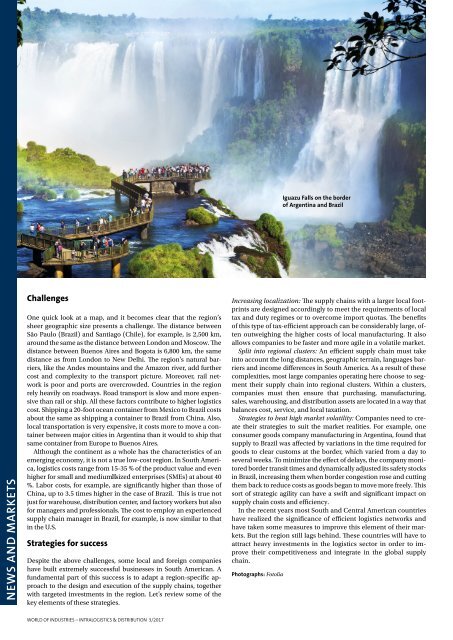WORLD OF INDUSTRIES - LOGISTICS 3/2017
WORLD OF INDUSTRIES - LOGISTICS 3/2017
WORLD OF INDUSTRIES - LOGISTICS 3/2017
- TAGS
- logistics
- intralogistics
Create successful ePaper yourself
Turn your PDF publications into a flip-book with our unique Google optimized e-Paper software.
Iguazu Falls on the border<br />
of Argentina and Brazil<br />
NEWS AND MARKETS<br />
Challenges<br />
One quick look at a map, and it becomes clear that the region’s<br />
sheer geographic size presents a challenge. The distance between<br />
São Paulo (Brazil) and Santiago (Chile), for example, is 2,500 km,<br />
around the same as the distance between London and Moscow. The<br />
distance between Buenos Aires and Bogota is 6,800 km, the same<br />
distance as from London to New Delhi. The region’s natural barriers,<br />
like the Andes mountains and the Amazon river, add further<br />
cost and complexity to the transport picture. Moreover, rail network<br />
is poor and ports are overcrowded. Countries in the region<br />
rely heavily on roadways. Road transport is slow and more expensive<br />
than rail or ship. All these factors contribute to higher logistics<br />
cost. Shipping a 20-foot ocean container from Mexico to Brazil costs<br />
about the same as shipping a container to Brazil from China. Also,<br />
local transportation is very expensive, it costs more to move a container<br />
between major cities in Argentina than it would to ship that<br />
same container from Europe to Buenos Aires.<br />
Although the continent as a whole has the characteristics of an<br />
emerging economy, it is not a true low-cost region. In South America,<br />
logistics costs range from 15-35 % of the product value and even<br />
higher for small and medium‐sized enterprises (SMEs) at about 40<br />
%. Labor costs, for example, are significantly higher than those of<br />
China, up to 3.5 times higher in the case of Brazil. This is true not<br />
just for warehouse, distribution center, and factory workers but also<br />
for managers and professionals. The cost to employ an experienced<br />
supply chain manager in Brazil, for example, is now similar to that<br />
in the U.S.<br />
Strategies for success<br />
Despite the above challenges, some local and foreign companies<br />
have built extremely successful businesses in South American. A<br />
fundamental part of this success is to adapt a region-specific approach<br />
to the design and execution of the supply chains, together<br />
with targeted investments in the region. Let’s review some of the<br />
key elements of these strategies.<br />
Increasing localization: The supply chains with a larger local footprints<br />
are designed accordingly to meet the requirements of local<br />
tax and duty regimes or to overcome import quotas. The benefits<br />
of this type of tax-efficient approach can be considerably large, often<br />
outweighing the higher costs of local manufacturing. It also<br />
allows companies to be faster and more agile in a volatile market.<br />
Split into regional clusters: An efficient supply chain must take<br />
into account the long distances, geographic terrain, languages barriers<br />
and income differences in South America. As a result of these<br />
complexities, most large companies operating here choose to segment<br />
their supply chain into regional clusters. Within a clusters,<br />
companies must then ensure that purchasing, manufacturing,<br />
sales, warehousing, and distribution assets are located in a way that<br />
balances cost, service, and local taxation.<br />
Strategies to beat high market volatility: Companies need to create<br />
their strategies to suit the market realities. For example, one<br />
consumer goods company manufacturing in Argentina, found that<br />
supply to Brazil was affected by variations in the time required for<br />
goods to clear customs at the border, which varied from a day to<br />
several weeks. To minimize the effect of delays, the company monitored<br />
border transit times and dynamically adjusted its safety stocks<br />
in Brazil, increasing them when border congestion rose and cutting<br />
them back to reduce costs as goods began to move more freely. This<br />
sort of strategic agility can have a swift and significant impact on<br />
supply chain costs and efficiency.<br />
In the recent years most South and Central American countries<br />
have realized the significance of efficient logistics networks and<br />
have taken some measures to improve this element of their markets.<br />
But the region still lags behind. These countries will have to<br />
attract heavy investments in the logistics sector in order to improve<br />
their competitiveness and integrate in the global supply<br />
chain.<br />
Photographs: Fotolia<br />
<strong>WORLD</strong> <strong>OF</strong> <strong>INDUSTRIES</strong> – INTRA<strong>LOGISTICS</strong> & DISTRIBUTION 3/<strong>2017</strong>
















